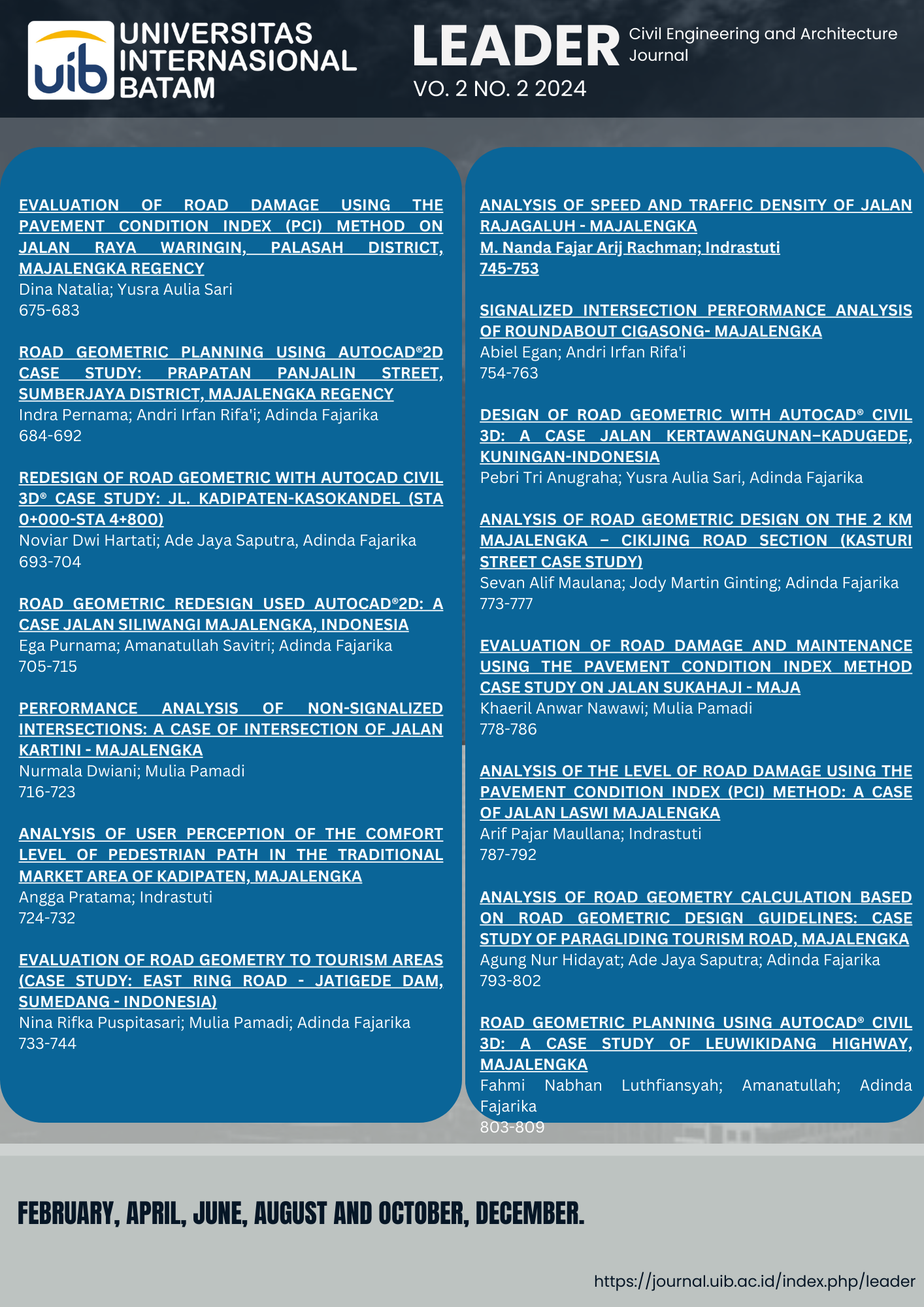EVALUATION OF ROAD DAMAGE USING THE PAVEMENT CONDITION INDEX (PCI) METHOD ON JALAN RAYA WARINGIN, PALASAH DISTRICT, MAJALENGKA REGENCY
DOI:
https://doi.org/10.37253/leader.v2i2.9532Keywords:
Road Damage Evaluation, Pavement Condition Index Method, Jalan Raya Waringin Section, Identification of DamageAbstract
Evaluation of road damage is an important process in monitoring and maintaining existing road infrastructure. The Pavement Condition Index (PCI) method is an approach that is commonly used to measure road conditions and identify the level of existing damage. Evaluation will be focused on the Jalan Raya Waringin section, to be precise in Palasah District, Majalengka Regency. This section will be selected based on its relevance, accessibility, and representation of overall road conditions in the area. The evaluation aims to assess road damage on Jalan Raya Waringin using the PCI method to get an overview of the condition of the road infrastructure. The assessment will help identify the extent and type of existing road damage Jalan Raya Waringin is a one-way road, with a width of 3.8 meters. From the results of the research data collection, it was obtained several types of damage occurred on the 250 m long section of Jalan Raya Waringin. Starting from the front of the Riyadul Huda Foundation to the front of the Adila motorbike (workshop), there is several damage such as Alligator Cracking, Potholes with a moderate level of damage (medium), and others. The results of the research on the condition of the Jalan Raya Waringin section, Palasah District, Majalengka Regency using the PCI method obtained an overall 47.8%. PCI Fair, meaning that the condition of the road pavement is quite significant and requires periodic maintenance. The types of damage that can be found in Jalan Raya Waringin, Palasah District, Majalengka Regency include Holes, Weathering and Loose Grain, Crocodile Skin Cracks, Longitudinal and Transverse Cracks, and Subsidence. Damages that occur as a result of subgrade soil conditions or unfavorable foundations. Weathering and Lose Grain, Crocodile Skin Cracks, Longitudinal and Transverse Cracks, and Collapse. Damages that occur as a result of subgrade soil conditions or unfavorable foundations.
Downloads
References
Ziyadi, M., Ozer, H., Kang, S., & Al-Qadi, I. L. (2018). Vehicle energy consumption and an environmental impact calculation model for the transportation infrastructure systems. . Journal of cleaner production, 174, 424-436.
Wardhana, M. A., Suharto, E., Setiawan, I., & Mulyanto, A. (2019). Pavement condition index as a tool for road maintenance prioritization in Indonesia. International Journal of GEOMATE,16(54), 35-45.
Smith, J. R., Johnson, A. B., Williams, C. D., & Brown, K. L. (2020). Localized evaluation approaches for assessing regional road network conditions. Journal of Transportation Engineering,Part B:Pavement, 146(2),04019023, 146.
Li, X., Liu, Y., Zhou, Y., & Chen, L. (2020). Localized evaluation approaches for assessing local road network conditions: A case study. Transportation Research Part C: Technologies, 118.
Smith, J., Johnson, A., Williams, C., & Brown, K. (2021). Prioritizing road maintenance activities using the Pavement Condition Index. Transportation Research Record,2675(9), 1-9.
Hicks, J., Turner, A., & Smith, D. (2018). Pavement Condition Index (PCI): A comprehensive definition and description. Transportation Research Procedia,32, 115-122.
Patil, R., Patel, S., & Choubey, V. (2020). Pavement Condition Index (PCI) as a tool for monitoring and managing road infrastructure. Journal of Traffic and Transportation Engineering,7(4), 400-407.
Al-Qadi, I. L., Lahouar, S., & Ozer, H. (2019). Components and data collection process in Pavement Condition Index evaluation. International Journal of Pavement Research and Technology,12(1), 1-9.
Wang, J., Han, Y., Gong, D., & Lu, C. (2021). Data collection and analysis for Pavement Condition Index (PCI) evaluation. Journal of Infrastructure Systems, 27.
Wang, G., Han, Y., Gong, D., & & Li, Q. (2018). Calculation methods and interpretation criteria for Pavement Condition Index (PCI) evaluation. Journal of Traffic and Transportation Engineering, 5(3), 216-223.
Zhang, S., Shi, X., Li, Y., & Liu, X. (2022). Advanced calculation methods and interpretation criteria for Pavement Condition Index (PCI) evaluation. Journal of Infrastructure Systems,29(1), 29.
Wang, J., Zhang, Y., Li, P., & Liu, Y. (2020). Assessment of rural road condition using Pavement Condition Index (PCI): A case study in a specific region. Journal of Rural Studies,80, 224-231.
Ahmed, N., Rahman, M. A., & Hasan, M. (2019). Evaluation of road conditions in an urban area using Pavement Condition Index (PCI). Journal of Urban Planning and Development,145(1), 145.
Smith, A., Brown, K., & Davis, R. (2018). Pavement Condition Index (PCI) as a tool for evaluating road damage and distress types. Transportation Research Record 2675(3), 68-77.
Johnson, R., Smith, J., & Williams, C. (2021). Utilizing the Pavement Condition Index (PCI) for prioritizing road maintenance activities and resource allocation. Journal of Infrastructure Systems,27(2), 27.
Garcia, M., Johnson, A., Smith, J., & Brown, K. (2019). Integration of LiDAR technology for improved Pavement Condition Index (PCI) evaluations. Journal of Transportation Engineering, Part B: Pavement, 145(4),04019019, 145.
Nguyen, T., Le, T., Pham, N., & Huynh, V. (2020). Application of machine learning techniques in Pavement Condition Index (PCI) evaluation. Journal of Intelligent Transportation Systems, 24(2), 143-155.
Li, Y., Wang, J., Zhang, S., & Liu, X. (2022). Assessment of road conditions in a neighboring district using the Pavement Condition Index (PCI) method. Journal of Infrastructure Systems,301(1),04021036, 30.
Fernandez, A., Rodriguez, C., Martinez, R., & Garcia, M. (2021). Benefits of using the Pavement Condition Index (PCI) to guide maintenance strategies: A case study. Journal of Transportation Engineering, Part B: Pavement, 147(1), 04020029, 147.
Chen, L., Wang, J., Li, X., & Zhang, S. (2022). Utilizing the Pavement Condition Index (PCI) for optimizing maintenance strategies. Journal of Infrastructure Systems, 31(2), 04021049, 31.
Hartawan, A., Suryono, E., & Prayogo, G. (2019). Challenges in data collection for Pavement Condition Index (PCI) evaluation. Journal of Civil Engineering, 7(1), 29-36.
Kurniawan, R., Pramudito, E., & Winarko, I. (2021). Subjectivity in distress rating interpretation for Pavement Condition Index (PCI) evaluation: A case study. Journal of Transportation Engineering, Part B: Pavements, 148(4), 040211082, 148.
Shahin, M. Y., & Walther, J. A. (1990). Pavement maintenance management for roads and streets using the PAVER system. CONSTRUCTION ENGINEERING RESEARCH LAB (ARMY) CHAMPAIGN IL, -.







